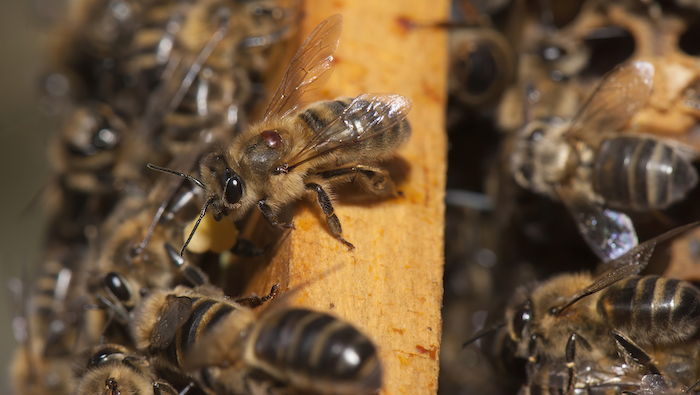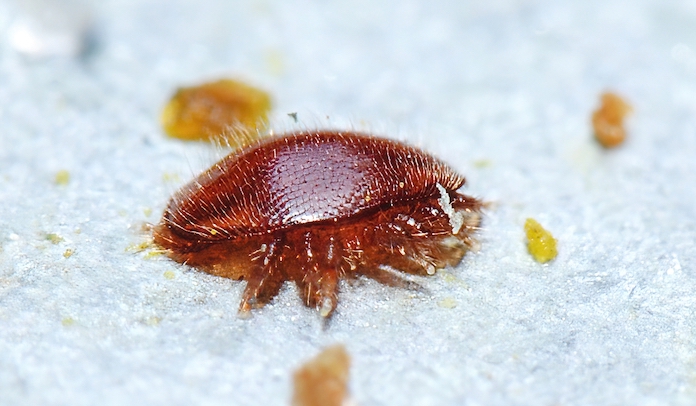Australia’s strict biological quarantine banning the introduction of honeybee products has kept it the only inhabited continent in the world free of the Varroa mite, a deadly bee parasite that targets the European honeybee (Apis mellifera).

Crisis: a Varroa mite infestation threatens the productivity of Australia’s beekeepers, who produce about $45 million worth of honey every year.
But after more than two decades of vigilance, Australia is now amid one of the most serious threats to our mite-free status since the parasite was discovered in ‘sentinel hives’ near the port of Newcastle in mid-June, then found in dozens of nearby hives.
Biosecurity zones have been established, and over a thousand hives in the area destroyed to attempt to wipe the mite out, with NSW and Federal governments recently announcing an $18 million compensation package for affected beekeepers.
The infestation threatens the productivity of Australia’s commercial and recreational beekeepers who produce around $45 million in honey each year, also delivering essential bee pollination services for many agricultural crops including almonds, cucumbers and canola.
What is the Varroa mite?
The mite attacking European honeybees is Varroa destructor, a parasitic tick which CSIRO scientist Denis Anderson identified as a separate species more than 20 years ago.
In evolutionary terms, this Varroa mite is only a recent introduction to the European honeybee, and it probably evolved from a mite that attacks the Eastern honeybee, Apis cerana.
Human intervention likely played a role in this species jump; because the European honeybee is such a good honey producer, it has been moved all over the world, including into a range where it overlaps with the Eastern honeybee, putting these species (and the parasitic mite) in close contact.
Destructor: the Varroa mite is a parasitic tick which CSIRO scientist Denis Anderson identified as a separate species more than 20 years ago.
The mite population can explode if unchecked and can overwhelm a honeybee colony, attacking the larvae, the adults, the Queen and the drones. The drones can drift between hives, spreading the infection.
Like most ticks, Varroa are also a very good vector for viruses which have co-evolved with the mite, so this combination of tick and virus is really damaging to the honeybee, because the host has no resistance or co-evolution with either tick or viruses.
Can Australia get rid of Varroa mite?
While the rest of the world has learned to live with Varroa, Australia has held off the mite for decades. We’ve had around 30 years to prepare, and the Department of Primary Industries (DPI) has been modelling this scenario exhaustively for over 10 years, annually revisiting plans to update them with the latest methods and information.
There’s a good chance Australia will be able to eradicate the Varroa mite thanks to the industry’s fast response to this outbreak – the main message is the importance of following the DPI guidelines.
The first line of defence is currently complete destruction of affected hives, to make sure that the parasite doesn’t spread, and close monitoring of eradication zones
Unlike New Zealand, where the mite had already spread widely by the time it was detected, Australia has found the mite during routine surveillance and, several weeks in, extensive testing has found local spread – but these identifications are all related to each other.
Can we treat hives that have the Varroa mite?
The first line of defence is currently complete destruction of affected hives, to make sure that the parasite doesn’t spread, and close monitoring of eradication zones.
However because the rest of the world has been dealing with this pest since the 1990s, if biosecurity measures fail and the mite spreads, there are treatments and controls that can lessen its impact.
My colleague, researcher Theotime Colin, is currently in France looking at a new effective technique to control the Varroa mite which involves isolating the queen bee so it stops laying eggs for a few weeks, interrupting the mite’s reproduction cycle (which depends on the brood).

Resilient: Varroa won’t wipe out Australia’s honeybee population but it’s important the industry follows guidelines from the Department of Primary Industries to minimise damage.
There are a number of chemical treatments including oxalic and formic acids and others – these can knock the bees around somewhat, but they hit the mite harder.
A Macquarie University research project funded by the Lord Mayor’s Charitable Foundation, has been assessing different Varroa mite treatments developed by the rest of the world, to identify which work best in the Australian environment.
There is also research into breeding European bees which have natural resistance, through “hygienic behaviour,” which has a strong genetic basis, and involves honeybees detecting infected larvae and ejecting a diseased brood out of the colony.
What’s next?
Varroa won’t wipe out Australia’s honeybee population – while the pest has spread around the world and causes a lot of problems for beekeepers, it has never driven the honey bee extinct.
New Zealand is just one example, where beekeepers have adapted to the presence of the mite since 2000. If Australia can’t eliminate the mite, we will learn to live with it as well.
But first, the most significant effort needs to be on eradication – and to this end, the honeybee industry and experts are all following guidelines from the Department of Primary Industries.
Professor Andrew Barron is an Australian Research Council Future Fellow and Deputy Head, Department of Biological Sciences at Macquarie University.








